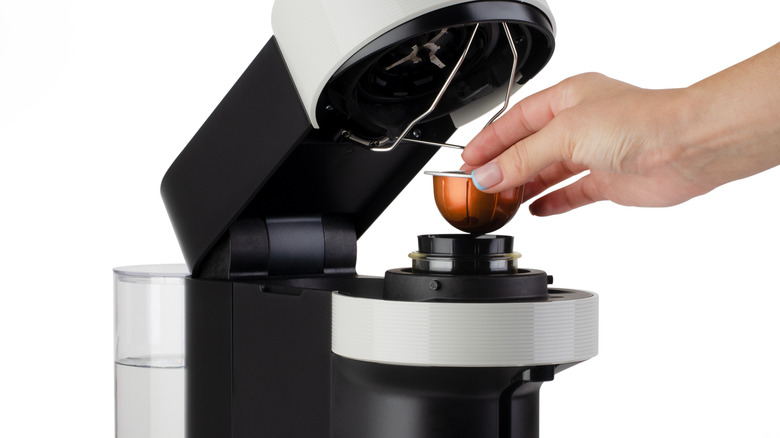Why You Should Release Nespresso Pods Immediately After Each Brew
Nespresso tips and tricks abound, spreading from user to user like an old-fashioned gossip chain. Fortunately, many of the insights are quite helpful, born from hands-on experience by true devotees of Nespresso. The coffee-cradling Nespresso pods (which we've ranked) get a whole lot of that shared love, including helpful hints on choosing, using, and not abusing them. Those last two categories, using and abusing, carry some unexpected nuances you'll want to know about.
Those charming little aluminum cups from Nespresso have several superior qualities compared to plastic versions. Along with being recyclable and requiring less packaging, the aluminum material seals out elements such as moisture, oxygen, and daylight. The freshness of the grounds is released only when activating the machine and brewing a cup of java. Once you pop a pod into the machine and hit the button, a group of spikes in the machine head pierce the aluminum seal, allowing the water to flow through the grounds and create your morning magic. You're done now — or are you?
Grabbing the freshly brewed Nespresso drink and dashing into your day is quite natural, but there's one small thing you still need to do: Release the used pod into the attached container. If you skip this step, bacteria can accumulate in the warm, soggy coffee grounds, eventually leading to mold buildup, depending on how long you leave it trapped in the chamber. And the pod itself is not your only concern.
Protect your Nespresso machine from a creepy-crawly mold march
After water runs through a Nespresso pod, it launches the journey of biodegradation and decomposition of the moist coffee grounds. It's a completely natural process but one that involves mold accumulation. That's not something you want happening inside your Nespresso machine. The pods themselves are easily discarded, but the metal machine spikes that pierced those pods can be exposed to growing mold from the wet coffee grounds. You don't want those musty creepy crawlies finding a home in there.
Releasing used pods into the dedicated container removes them from the inner alcoves of your Nespresso machine, but there's still more to consider. Mold can start to accumulate and grow in as little as 12 to 24 hours, thriving prolifically when water and food are involved. Even after properly dispensing the pods, where they'll join the gang of wet pods from previous days, the mold party will continue. You'll want to empty that container as often as possible and occasionally spray some water over the metal spikes.
Nespresso provides recycling bags to customers on request, allowing free shipping of used pods to dedicated collection points across the world. This is an excellent way to participate in Nespresso's sustainability commitment, but you do want to take precautions as the wet pods accumulate. It's best to store the Nespresso recycling bag in an outside trash can until dropping it at your local designated spot.

